According to scientific research, one of the main reasons why cats lick and groom each other may be a sign of dominance. Cats have their own social hierarchy in which some cats are more dominant and hold a higher social position than others.
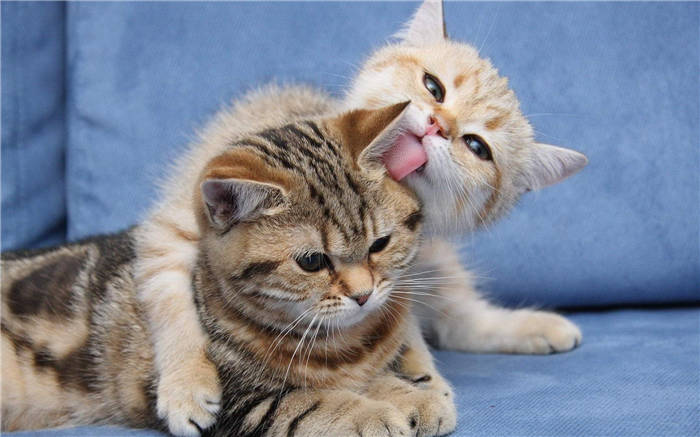
- Why do cats lick and groom each other?
- Do cats lick each other as a sign of affection?
- Why a cat licks its owner
- Ways to eliminate this habit
- A cat licking a cat
- An in-depth look at feline allogrooming
- 3 reasons cats care for each other
- As a sign of dominance.
- How do cats groom each other?
- What does the research say about allogrooming?
- 7 reasons why adult cats lick each other. Can the parent cat lick the kitten
- 7 reasons why cats lick each other
- The maternal instinct
- Maintaining Status
- Cats lick each other in order to get close to each other.
- Cats lick each other to strengthen family bonds.
- Why cats lick each other
Why do cats lick and groom each other?
If you have several cats in your home, you have probably noticed more than once how your pets lick and groom each other. This behavior, called "allogrooming" (social grooming among members of the same species), is usually attributed by cat owners to affection or a desire to help clean up. But there seem to be several other reasons why cats lick and groom other cats. These include friendliness and hygiene, but there are other reasons why your cats may lick each other: asserting dominance, maternal instincts and comforting the sick.
Cats are known for their neatness. They like to be clean, and they spend a lot of time trying to achieve it. But as flexible and dodgy as cats are, they can't always reach all their body parts to clean them. Sometimes they need a little help (especially when it comes to the neck and head area), and that's when she'll find another cat reaching out with her paw.
Do cats lick each other as a sign of affection?
Sometimes your cats may lick each other just to say, "Hey, you're okay." Like dogs with their penchant for friendly licking, one cat's licking and wooing of another can be seen as a signal that they enjoy each other's company. However, cats have other ways of showing that they like each other, such as rubbing each other or head bumping. So, if your cats aren't licking each other, it doesn't necessarily mean they aren't friends.
Licking and grooming as a sign of affection is the same as licking and grooming to strengthen social bonds. Social grooming often occurs among cats who are related or well acquainted with each other (this means you won't see your cat grooming an unfamiliar cat). In fact, cats that are related by blood and cats that are not related but grew up together will encourage family bonding through social grooming. By licking and grooming each other, your cats also demonstrate trust in each other.
If one of your cats approaches the other to ask for grooming, they show a certain level of vulnerability, which shows trust. Finally, by grooming each other, your cats can exchange smells. Smells, demonstrating trust and encouraging family bonding all help bring your cats closer together. And if your cat licks you? It shows you that you are a member of the family!
Why a cat licks its owner
There are also a number of other factors that trigger a domestic cat's habit of licking its owner. The cat may have friendly feelings toward its owner.
The mother cat licks her kittens from birth, showing concern for her offspring. As the kitten grows older, it begins to lick its siblings. If a cat starts licking its owner's hands, for example, it can be seen as a show of care.
Another reason why a cat licks a person's hands is to indicate who holds the dominant position. The licking of the owner's hands is another reason for the cat to lick the person's hands. When licking the owner, the cat leaves a piece of the scent, thus proving to all other animals that it is his person. If the cat shows no aggressive feelings, then you need not worry about it.
Begging for treats is not uncommon for cats, so they may take such a step as licking the owner's hands. This should not be allowed, because the cat will become completely spoiled and unmanageable.
Feed the pet strictly according to the food schedule. You should not give treats, especially from the human table.
Ways to eliminate this habit
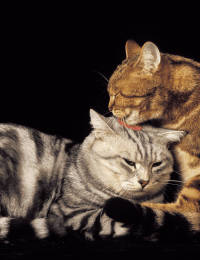
In case the owner of licking the cat brings discomfort, it is necessary to get rid of this behavior gently. For this purpose, a special toy should be purchased with which you can distract the animal every time it makes an attempt to lick. In some cases catnip is excellent. You can purchase a ball with a smelly grass inside.
Distracting the animal can be played with. This is especially true for small kittens, whose habits are just getting stronger. Playing with the pet not only helps to instill good habits, but is also useful for the overall development of the animal. In addition, if the animal is stressed, the biological substances produced by the body during physical activity allow it to relax.
It is difficult to retrain an animal that is used to it, so you must have patience. We must handle retraining gently, without raising your voice, without punishing the animal, without frightening him harshly. Categorically push the cat away and throw it to the floor.

Due to the high volume of questions coming in, free veterinary consultations have been temporarily suspended.
A cat licking a cat
Most of the time, a cat that licks pays attention to areas such as the cheekbone area, the scruff of the neck and the vertex. In addition to familiarity, cats show concern for each other by grooming their coats.
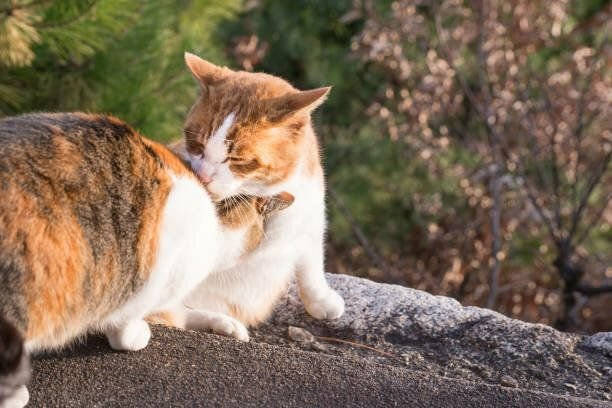
Regarding the question of a cat licking another cat, it becomes clearer. But how to explain the cat's behavior when it licks the dog. Some owners notice that the cat rubs its face and torso against the dog. First of all, this is a kind of marking.
In the corners and around the cat's mouth there are specific glands. They are also located in the temporal area. During rubbing, the glands open and the specific secret remains on the object the animal rubs against. The glands are also located at the base of the tail.
It is an interesting fact, proven by zoopsychologists, that cats, feeling stronger in the hierarchical ladder, lick the weaker, proving their supremacy. Cats can also lick their owners in response to being petted, thus showing their gratitude.
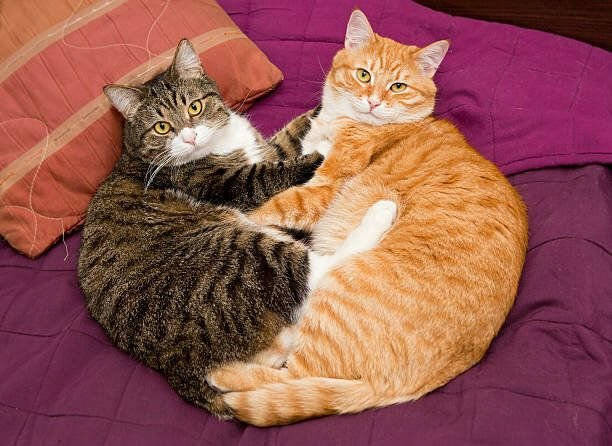
Due to the high volume of incoming questions, free veterinary consultations have been temporarily suspended.
An in-depth look at feline allogrooming
To understand why cats groom each other, you need to know how cats groom each other. It's not as simple as it may seem. For example, not all cats respond positively to allogrooming, some cats always end up on the receiving end, and the gender of your cats certainly plays a role in who is the "groomer."
Below is data from a 1998 study on feline allogrooming and related trends:
- Almost all allogrooming sessions focused on the head and neck area.
- 94% of allgrooming sessions occurred after one cat intentionally approached the other (translation: Cats were not yet lying next to each other when it started).
- In 91.6% of cases, one cat was the groomer and the other was the groomer (this is not mutual grooming – one cat dominates and the other submits).
- In 75% of the allogrooming sessions, the cat with the higher rating acted as the dominant.
- In 70% of the allogrooming sessions, aggression came from the groomer, not from the cat.
- In 65.4% of allogrooming cases between males and females, the male cat acted as the groomer.
- In 43.6% of the cases the groomer (the cat with the higher rating) sat upright.
- 12% of allgrooming sessions ended in a fight.
It is also interesting to note that fixed status, kinship and the desire to show affection rarely play a role in these social grooming sessions. And as soulful as these grooming sessions may seem, they most often stem from feline instincts.
3 reasons cats care for each other
If you have at least two cats in your house who are tightly bonded, you've probably witnessed an allogrooming session at least once or twice. However, your cats weren't petting each other to say, "I love you," even if they were purring and seemed to be enjoying themselves in the process.
As a sign of dominance.
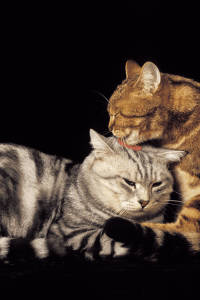
Who is the most dominant cat in your house? If you don't know, dominant cats usually claim more territory (by scent tagging or sprinkling), deliberately attack and intimidate lower-ranked cats in your home, and dominate both bowls of food at dinner time. Most cats will lick the other cat to affirm their "social standing," just as a mother cat licks her kittens.
Licking spreads the dominant cat's scent onto the subordinate cat's skin (a way of marking it) without having to take out your dominance with aggressive behavior such as fighting, biting and snarling. One of your cats may be at the top of the feline hierarchy in your home, as evidenced by this grooming behavior – your dominant cat usually sits upright. The other cat, on the other hand, puts out her sensitive neck or head for grooming, a sign of submission.
How do cats groom each other?
There is no doubt that cats are sanitary creatures. Striving for well-groomed coats, disinfected wounds, and skin clean of dirt, cats will:
- Lick their coats in small patches (removing any traces of their "scent," loosening dirt and keeping their coats lubricated).
- Chew or pluck the tangles to give the coat a smoother texture
- Lick their paws for a quick muzzle wash (while cleaning their ears, eyes and forehead).
- "Trim" their nails with aggressive chewing (all they do is remove the sharp outer shell)
In the case of a feral cat who wants to stay warm, pest-free and "hide" from predators, grooming becomes more of a survival instinct. Therefore, independent grooming is much more in-depth and purposeful than those adorable allogrooming sessions.
Most helpful cats limit their grooming to the neck, head, forehead and ears of another kitty. Cats who appreciate this impromptu bathing may even bare their necks or tilt their heads for better access and more thorough cleaning.
What does the research say about allogrooming?
We may not know why cats feel "itchy" after they poop, or prefer cardboard boxes to polyurethane foam (though we can guess), but allogrooming is relatively well studied.
In a 1998 paper entitled "Allogrooming Function in Domestic Cats (Felis silvestris cams)," researchers learned why, when and how cats clean each other.
- Only 8% of these group grooming sessions are "mutual" (this is not a "You get my back and I'll get yours" type scenario).
- Of all group grooming sessions, about 12% end in a scuffle.
- The more submissive of the pair acts as the "groomer" only 25% of the time.
- Almost 47% of groomers are "alpha" cats – they sit upright, extending a helping paw.
- In male-female duos, the male takes the lead in grooming more than 65% of the time.
- When grooming takes a fiercer turn, the groomer becomes the instigator of 7 out of 10 fights.
Only 6% of these "baths" occur in the head and neck area, and 94% are due to one cat approaching the other. Interestingly, these results remained consistent despite siblings, parent/child duo, or non-parent cats, and whether or not the cat had been vaccinated.
7 reasons why adult cats lick each other. Can the parent cat lick the kitten
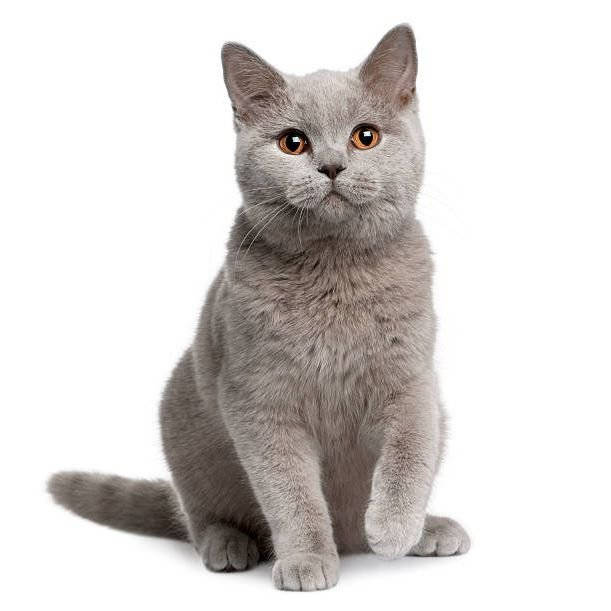
A cat's tongue is covered with small, rough "hairs," so licking them is as much like brushing a coat as possible. By licking itself, the cat escapes the heat. The fact is that the coat becomes wetter, the cat's body temperature becomes lower and the fluffy friend feels better.
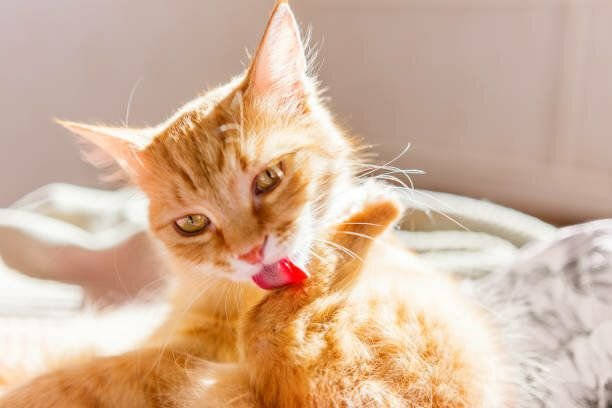
If the cat starts licking immediately after you took it in your hands, don't worry, it does not mean that the cat is squeamish or thinks you are "dirty".
This is how a cat gets its natural scent back, so that it doesn't attract the attention of dangerous predators. A mother cat instills in her baby from childhood that he should be clean and have his natural scent.
Do not underestimate the cat's emotions, even if you surround the cat with care and attention, he may be stressed by various irritants, for example, the cat may have health problems.
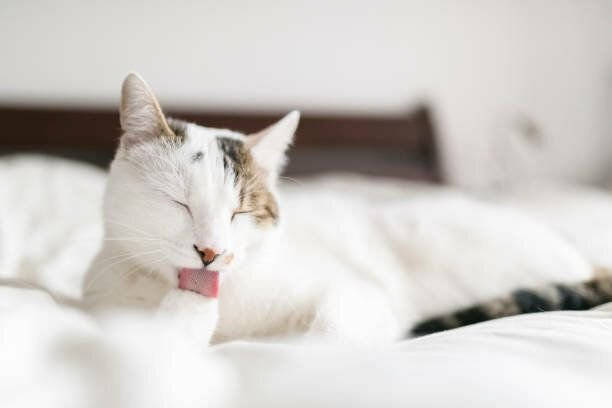
If you notice that the cat has started to wash too often and there are bald spots on its fur due to intensive licking, it is better to contact your veterinarian so that he can prescribe the right treatment and identify the cause of the cat's stressful behavior.
7 reasons why cats lick each other
Cats show a good relationship with each other by licking. And if little-known cats lick each other's fur, they want to get to know each other better and get to know their neighbor better.
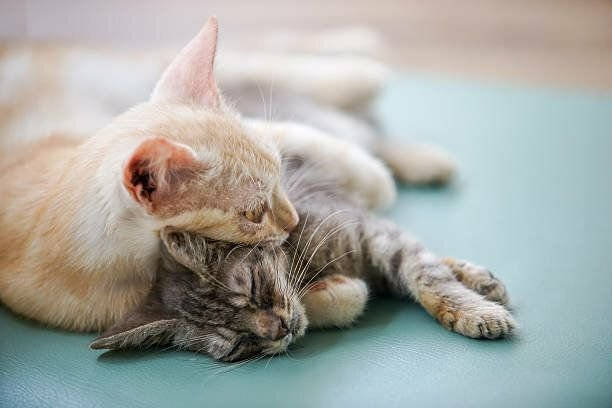
Cats who live together since childhood have a great respect for family values. By licking each other, they show that their family bonds are strong. In this way, they prove that their bond from childhood has been preserved.
❗ If a cat also licks you with its tongue, congratulations – you've been accepted into the furry family!
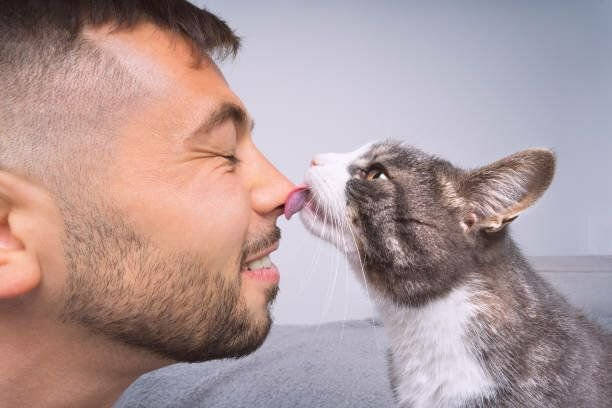
A mother cat often licks the kitten. And the adult cat, wanting to plunge into the warm atmosphere of childhood, also begins to lick the other pet.
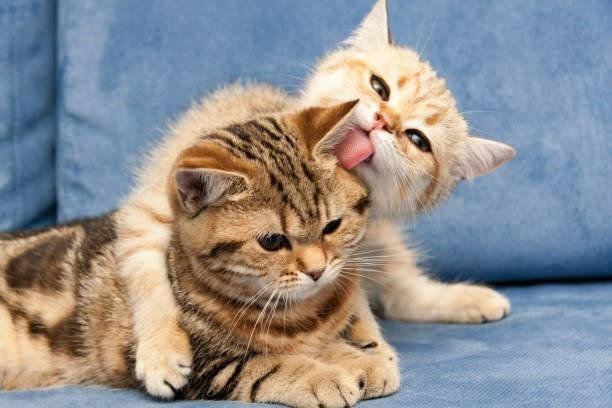
Often cats can't reach the back of the head by themselves to clean the fur there. In this case, another cat may come to the rescue.
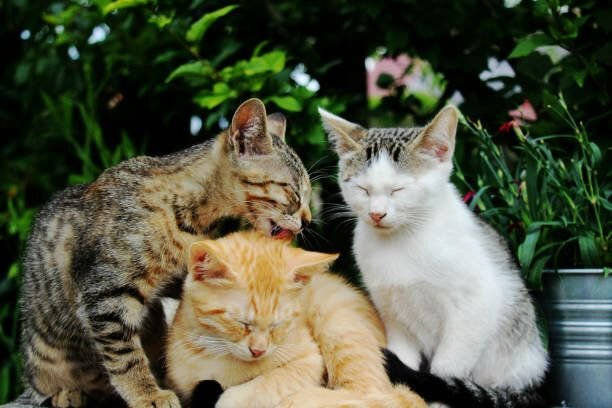
Another reason why cats lick each other is because of emotion. Even if the cats spend most of their time in full understanding, sometimes one of them can make a mistake and offend his neighbor in some way.
But sometimes cats do not want to fight (why expose themselves to danger?), and therefore they find another way to show their emotions. Sometimes the reason why cats lick each other is exactly the negative aspect – although outwardly the process is still similar to caring.
The maternal instinct
The licking of her kittens by the mother cat shows not only the hygiene of the babies, but also other things that are necessary for the life of the cubs:
By three weeks, kittens can already lick themselves. Then they begin to lick their siblings, reinforcing the bond of kinship. A cat can continue to lick her babies even as an adult. Scientists have observed that the babies of unscrupulous mothers who have poorly cared for their brood grow up to be just as sloppy.
Maintaining Status
It may seem strange, but when living together cats also build a certain hierarchical ladder. And most often dominant individuals demonstrate their status in the safest way – by licking less respected cats. That's how they maintain their status. But this is just a hypothesis, it all depends on the nature and temperament of cats.
Cats, like people, also need to exchange information. But they do it in their own way. The main methods of communication are meow or purr, body language, smell and, of course, tactile touch, including licking.
Licking helps a cat to maintain contact with its congeners or the owner. In relation to other cats, it may not only mean a demonstration of dominance, but also extreme appreciation and love for a fellow cat.
The better the cats know each other, the more likely they are to lick, whether it is a friendly relationship, a relationship between cat and cat, or between mother cat and kitten. It is unlikely that a cat will lick a stranger, which makes sense, since they only do such service to "trusted" and well known individuals.
Perhaps you have noticed that sometimes during the mutual licking the cats begin to fight or bite. This happens because one of the fluffy cats gets tired of these caresses and to stop it, he begins to use his teeth and claws. And sometimes they just play around.
If your pet licks you, you can assume he accepts you as a family member. He trusts you and respects you. But there are other reasons why a cat will lick you:
- Cats always get the same smell from everyone in the family;
- Maybe the cat doesn't like your scent or you have stroked other animals before, so it tries to remove that scent with its own licks;
- Salty skin is especially appreciated by cats, as it replenishes some of their nutrients.
Cats lick each other in order to get close to each other.
This daily process is not always functional. Some cats, when together, may lick each other to show love and trust in their mate. The licking serves to strengthen the bond between the pets.
How do you know if the animals are really close to each other? In such cases, licking is usually focused on the face and ears, the cats' favorite places to show affection
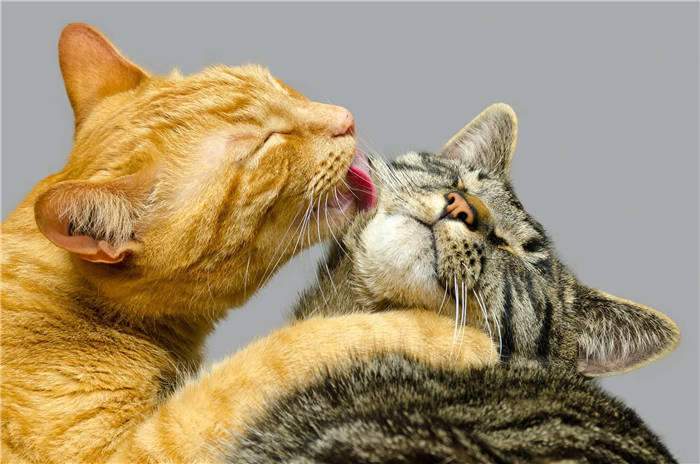
Cats lick each other to strengthen family bonds.
Adult cats often spend a lot of time licking their cubs. They do this both to identify them as members of their family and to alert others that the kittens are part of their territory.
If the mother does not lick her kittens enough, it can cause an odor change that may even lead to rejection. This process reinforces the necessary bonding, without which serious problems can arise. Even when the kittens are older, they will continue to lick each other to strengthen the family bond.
This point may lead to the question of why a cat licks its owner. It means that she considers the person a member of her family.
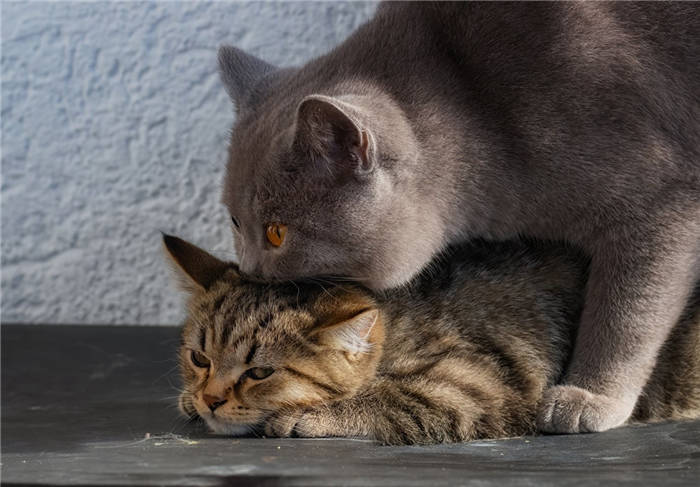
Why cats lick each other
The fact that cats lick themselves at every opportunity (after contact with people as well) is known to all owners of purrs. If two whiskers live in the apartment at once, the owners will witness synchronous washing and even licking each other. Why do cats do it?
There are several reasons. They are simple, but interesting. Feline logic becomes immediately understandable.
Animal behavior does not lend itself to human logic. Many things are incomprehensible to bipeds in the movements of pets. Today we'll figure out why cats living in the same apartment wash each other.
First There can really be sympathy between them. Not necessarily blood ties, but mutual love, as between close relatives. After all, two pets share the same territory without quarreling, why not help wash the neighbor? This is how they show affection for a member of their family, the pack. A cat will never lick a strange animal! More often than not, cats that were taken into the same family at the same age take care of each other.
Cats love cleanliness. This is second reason They will wash not only themselves, but also their neighbor, to keep everything around them clean and to communicate comfortably.
A little selfishness: cats can't reach all parts of the body, so they use their mate's tongue to wash the areas they can't reach on their own.
Mama cats wash kittens for the same reason: the crumbs themselves are not yet able to take care of themselves, so the adult will often lick them. This is how kittens become accustomed to daily toiletting. From the 4th week kittens learn from their mother and begin to lick themselves.
The third reason is due to the cat's hierarchy and status. Yes, there are social structures in the cat world. Studies have found that cats of higher rank wash their inferior congeners.
In addition, wash-keepers can behave in a passive-aggressive way, hissing at those they lick, once again demonstrating their power and high status. In this way they secure their territory. Suddenly, a cat of a higher rank wants to lie down on the place of a congenie, and then it will start licking another animal until it leaves the occupied territory. Sometimes licking is not an act of love, but a reinforcement of power play.






